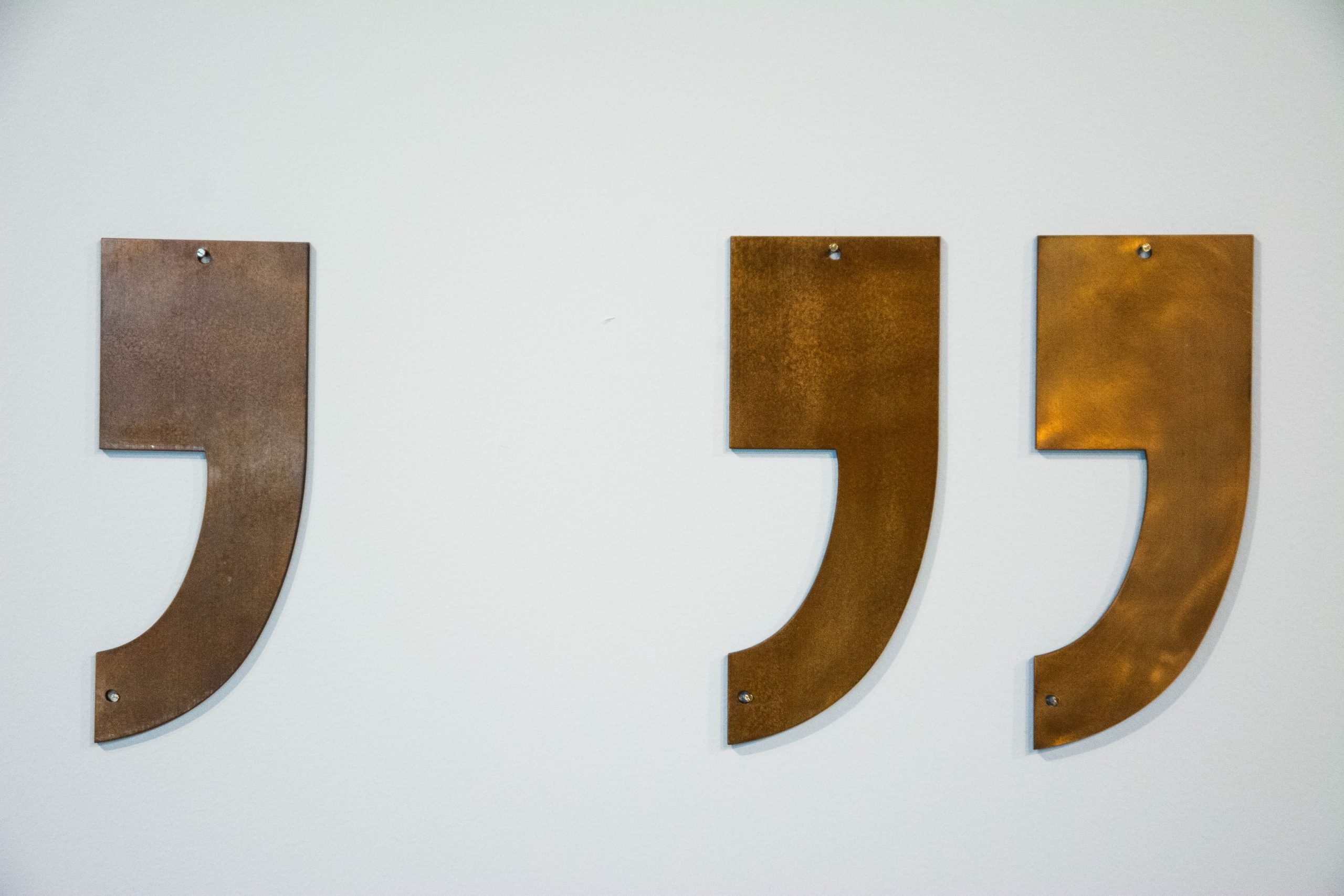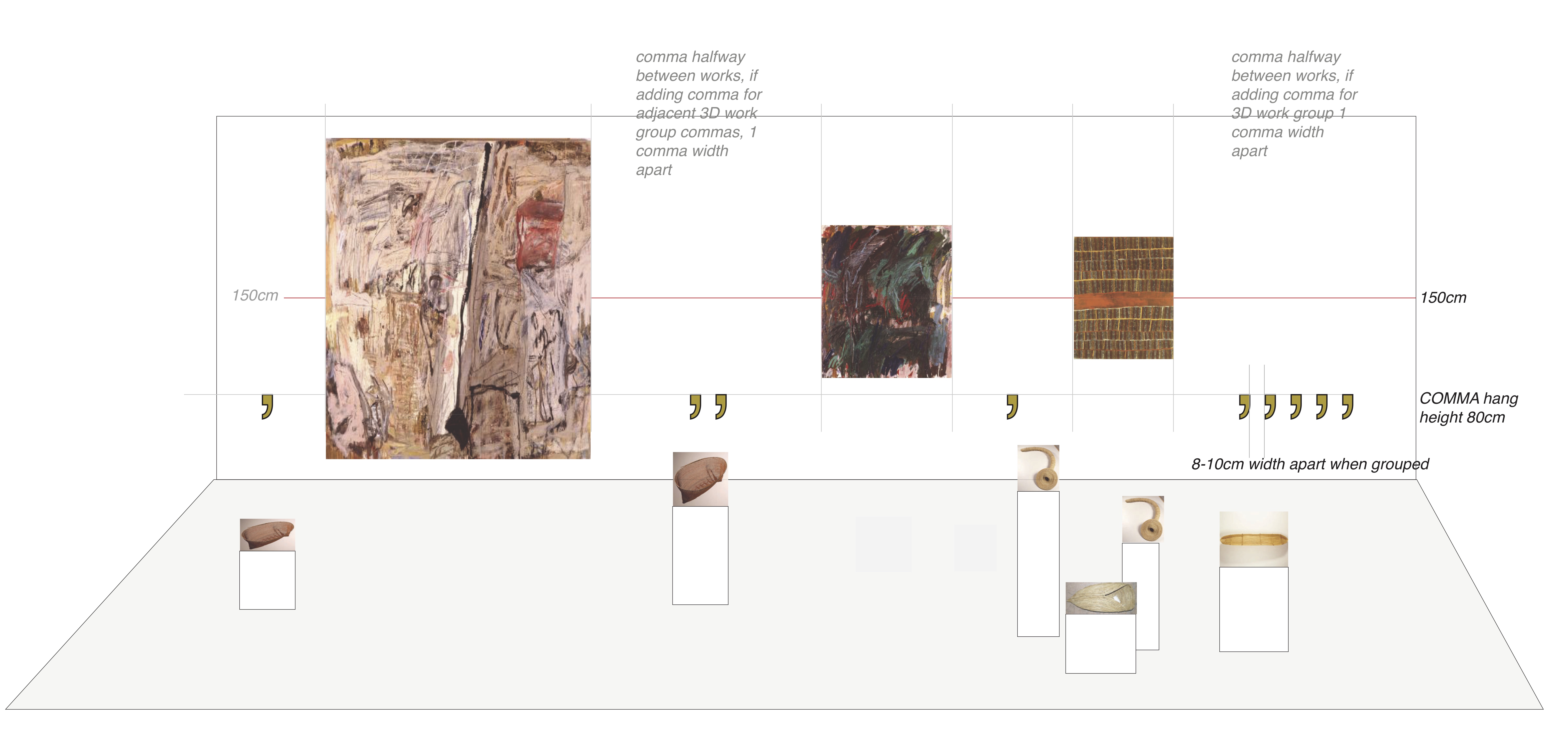Art

Installation, Flinders University Museum of Art. Photograph: Lana Adams.

In 2018 The Countess Report was invited to participate in the exhibition Borrowed Scenery at Campbelltown Art Centre (C-A-C).
In formulating our response to the exhibition we were interested in experimenting with a style of working that could operate as both artwork and advocacy. We wanted to explore the use of data and its relationship to Countess’ feminist politic from philosophical and conceptual perspectives, alongside our usual instrumentalization of data as a tool for benchmarking and transparency within the arts.
The work we produced comprised of three parts:
- ‘52 commas’, 2018, bronze
- A room sheet which provided perspectives data from the collection, and relevant policy documents related to the collection.
- Closing night presentation, written by The Countess Report, performed by artist Safari Lee. (see Countess @ C-A-C part II)

‘52 commas’ was informed by the importance of the comma as a delimiter in data analysis. The comma is an object that both separates fields of data and indicates a pause, or a moment of reflection between one idea/artwork/data field to the next. At C-A-C the number of commas corresponds to the number of artworks in the Borrowed Scenery exhibition. The work was installed between each artwork at the height of our knees, in lieu of didactic wall panels. The commas were as reliant on the artworks in the exhibition as the artworks were on ours.
In June 2019 we accepted C-A-C’s invitation to offer feedback and advice on an updated institutional collection policy that has been drafted in response to our findings on gender disparity.
52 Commas has been shown in various additional iterations including:
9 Commas as part of the exhibition Female Drivers (cur. Madeline Snow) at Maitland Regional Gallery in 2021;
and 11 commas in the exhibition Data Imaginary (cur. Angela Goddard) at Flinders University Museum of Art in 2022.

Installation mock up, 52 Commas
Read more:
http://rundog.art/borrowed-scenery-nevertheless-she-persisted/
https://artguide.com.au/borrowed-scenery-focuses-on-female-artists
https://visual.artshub.com.au/news-article/reviews/visual-arts/gina-fairley/review-borrowed-scenery-campbelltown-arts-centre-257225
https://www.backyardopera.com/art-culture-6/2018/12/22/borrowed-scenery-gender-framing-and-the-arts
https://www.art-almanac.com.au/borrowed-scenery/
http://f-magazine.online/borrowed-scenery/
The following is an extract of a talk written by Countess and performed by artist Safari Lee wearing head to toe leather at the exhibition closing event on 8 March 2018.
In true dominatrix style she cracked the whip as she read out our report on C-A-C’s collection, the flaws in its commissioning process and why we produced bronze sculpture as part of our contribution to the exhibition.
In true dominatrix style she cracked the whip as she read out our report on C-A-C’s collection, the flaws in its commissioning process and why we produced bronze sculpture as part of our contribution to the exhibition.

COUNTESS: ON CAMPBELLTOWN ARTS CENTRE
In November 2018, The Countess Report team spent a full day at Campbelltown Arts Centre ‘auditing’ their organisation. We were given full access to all data and exhibition reports for ach artwork in their collection.
We felt warmly welcomed into the organisation, but what was our role? To provide flashy data visualisation? To use our artist fee to ‘improve’, ‘diversify’, ‘restructure’ the organisation? Countess jostled to find a place within the Borrowed Scenery project.
If we weren’t making an artwork did that make us consultants? We wondered if it was appropriate that such an underfunded and overworked DIY organisation should take on this
role?
Can institutional critique be genuinely invited? What are the bureaucratic levers that can be weaponised, tweaked or used as material when analysing Campbelltown Arts Centre and is there value in using these in a creative or conceptual manner? Can we make the Director and the institution work hard to interpret our work in the same way we have had to work hard to interpret theirs?
COUNTESS: ON NUMBERS
Countess is in the business of numbers.
Numbers can get exhausting. It’s never really just the numbers we are interested in anyway, but what sits beneath them. What has informed them and what makes them so resilient and enduring?
Should 50/50 be the goal? We like the sentiment shared by Eva Cox when she quotes the logan from a 70’s badge: “Women who want equality with men lack ambition”.
We applied this logic to the collection of data itself. What gives it structure, form and integrity? In many computer languages commas are used as a field delimiter to separate arguments to a function, to separate elements in a list, and to perform data designation on
multiple variables at once. Basically, the comma allows for space and separation between numbers so that percentages and proportions can be calculated.
COUNTESS: ON VALUE
At Countess HQ we talk a lot about ‘value’ – who decides on it? How does it come about? How is it measured? Certified, professional valuers are engaged by institutions like Campbelltown Arts Centre as contractors, to officially ‘value’ artworks that the institution is interested in acquiring. These are artworks that have been recommended by CAC staff as potentially worthy to enter into the collection.
Perhaps it sounds obvious, that works entering a collection should be worthy, useful, desirable, beneficial, significant. But over the course of our research at Campbelltown Arts Centre we read though tens of these valuation statements and the more we read the more ambiguous, subjective, self-selecting and dodgy-as-shit these words began to seem.
COUNTESS: ON ACQUISITIONS
Without an ongoing collection budget, Campbelltown Arts Centre relies heavily on acquisitions via donations. Paintings, prints, drawings, sculptures, digital and new media work, weavings and ceramics. Have you heard of the federal government’s Cultural Gift Program? If you are an artist, we recommend you look this up.
How do you feel about making work to donate work? How do you feel about donating work as a tax benefit? How do you feel about being acquired? Do you have a preference on where in the storeroom your work is stored?
All donations must be checked against the Campbelltown City Council Collection management policy, which provides some guidelines for what constitutes a worthy acquisition. According to this document, which is accessible online, artworks considered for acquisition should be of “Highest artistic standard” and “meet the quality criteria”.
The quality criteria point that we gravitated towards was this one:
“Artworks, which by their size or characteristics, are considered to be permanent fixtures requiring considerable attachment to part of the structure of the building shall not be accepted for the permanent collection unless such artworks are considered to be of outstanding artistic merit and recognised as valuable to the development of Australian art”
This was part of our reason for casting our commas, so that by way of installation we could considerably attach to the structure of the building our artwork of outstanding artistic merit.
I’d like to reiterate a comment by an attendee of a the recent Seniors week program at Campbelltown Art Centre who suggested the institution permanently attach at least one
comma somewhere in the gallery.
COUNTESS: ON BEING CONSULTANTS
We had many conversations about what it meant to be consultants or artists. Could our “work” on data ‘improve’ the structure of an organisation?
Countess.Report is an artist run initiative. Independent always. Our evidence is often cited, but we are still DIY. We work online and in the real world. We are a public resource. And we are bad at self-promotion. Our artwork in Borrowed Scenery was a workaround to being framed as consultants.
Data will always be our core activity. But we are artists, and we want our labour and skills to be displayed, take up physical and cultural space and blur this whole consultancy question.
And after all this there is some talk of our work being acquired (read: donated) and if this happens we just ask that it is stored up high in the collection storeroom with a vantage point good enough to be able to look over the other works and make sure that Strategy 3.7 from the 10-year Asset Management Strategy is upheld: all assets are managed strategically,
transparently and efficiently.
Art galleries across Australia. We invite you to invite us to be part of your next project. Countess. Women count in the art world.
